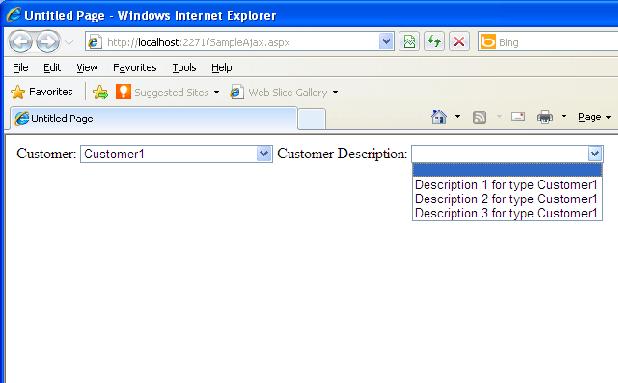Introduction
This article describes how to use AJAX functionality using the popular JavaScript library (jQuery) with a minimal amount of code without using ASP.NET 2.0 AJAX tool kit. ASP.NET 2.0 does not support JSON so this will help if you want to use ASP.NET 2.0.
This example has two drop down controls for customer and customer description. Customer description will be loaded when customer drop down changes without reloading the entire page.

Using the Code

- JQuery library files need to be included to the project as shown above.
These are the library files:
- jquery-1.4.1-vsdoc.js, jquery-1.4.1.js
- query-1.4.1.min.js
- jquery-1.5.2.min.js
- jquery-ui-1.8.11.custom.min.js
Sample_ajax.js file will have Ajax implementation using JQuery.
var ajax = {
setDebugMode: function(){
this.debugMode = true;
},
get: function (requestUrl, data, loaderImageId, onSuccess, onComplete) {
if (loaderImageId) {
$("#" + loaderImageId).css('display', 'inline');
}
var completeFunction = function () {
if (onComplete) {
onComplete();
}
if (loaderImageId) {
$("#" + loaderImageId).css('display', 'none');
}
};
$.ajax({
type: "GET",
url: requestUrl,
data: data,
context: this,
success: function (response) {
onSuccess(response);
completeFunction();
},
error: function (response) {
alert("Ajax Request Failed");
this.showError(response);
completeFunction();
}
});
},
post: function (requestUrl, data, loaderImageId, onSuccess, onComplete) {
if (loaderImageId) {
$("#" + loaderImageId).css('display', 'inline');
}
var completeFunction = function () {
if (onComplete) {
onComplete();
}
if (loaderImageId) {
$("#" + loaderImageId).css('display', 'none');
}
};
$.ajax({
type: "POST",
url: requestUrl,
context: this,
data: data,
success: function (response) {
onSuccess(response);
completeFunction();
},
error: function (response) {
alert("Ajax Request Failed");
this.showError(response);
completeFunction();
}
});
},
showError: function(requestObject){
if (this.debugMode){
alert(requestObject.responseText);
}
}
};
ASPX Page (SampleAjax.aspx)
Include the JavaScript as below:
<script type="text/javascript"
src='<%= this.ResolveUrl("~/Scripts/jquery-1.5.2.min.js")%>' ></script>
<script type="text/javascript"
src='<%= this.ResolveUrl("~/Scripts/jquery-ui-1.8.11.custom.min.js")%>' ></script>
<script type="text/javascript"
src='<%= this.ResolveUrl("~/Scripts/sample_ajax.js")%>' ></script>
Write JavaScript to call customer descriptions when customer drop down changes.
<script type="text/javascript">
<% if (SampleJSONWeb.ConfigurationData.DebugMode){ %>
ajax.setDebugMode();
<%} %>
$(document).ready(function ()
{
$("#<%= customerDropDown.ClientID %>").change(function ()
{
var customerTypeId = $('#<%= customerDropDown.ClientID %>').val();
ajax.get('<%= this.ResolveUrl("~/LoadCustomerDescriptions.ashx")%>',
{ 'customerTypeId': customerTypeId },
'CustomerDescriptionsLoader',
function (response)
{
$('#<%= customerDescriptionDropDown.ClientID %>
option').remove();
for (var i = 0; i < response.Data.length; i++)
{
$('#<%= customerDescriptionDropDown.ClientID %>').
append(getOptionString(response.Data[i]));
}
}
);
});
function getOptionString(dataElement)
{
return "<option value='"+dataElement.Id+"' >"+dataElement.Name+"</option>";
}
});
</script>
LoadCustomerDescriptions.ashx will be invoked by the above JavaScript.
public class LoadCustomerDescriptions : JsonRequestHandler
{
public override void ProcessRequest(HttpContext context)
{
string customerTypeId = context.Request.QueryString["customerTypeId"].ToString();
GetData getData = new GetData();
IList<ReferenceData> data = getData.GetCustomerescriptions(customerTypeId);
data.Insert(0, new ReferenceData(string.Empty, string.Empty));
Dictionary<string, string> response = new Dictionary<string, string>();
response.Add("Data", GetJsonCollection<ReferenceData>(data));
SetResponse(context, response);
}
}
The above method gets the data from the back end and sends back as JSON format. JSON handler has the implementation to manage JSON data as below:
using System;
using System.Collections.Generic;
using System.Web;
using System.Text;
using System.Reflection;
using System.Web.SessionState;
namespace SampleJSONWeb
{
public abstract class JsonRequestHandler : IHttpHandler, IRequiresSessionState
{
public abstract void ProcessRequest(HttpContext context);
protected void SetResponse(HttpContext context, string jsonResponse)
{
context.Response.Cache.SetExpires(DateTime.Now);
context.Response.ContentType = "application/json";
context.Response.Write(jsonResponse);
context.Response.End();
}
protected void SetResponse(HttpContext context,
Dictionary<string, string> attributes)
{
SetResponse(context, GetJsonObject(attributes));
}
protected void SetResponse<T>(HttpContext context, T obj)
{
SetResponse(context, GetJsonObject<T>(obj));
}
protected T CreateObjectFromRequest<T>(HttpContext context) where T: new()
{
T ob = new T();
PropertyInfo[] properties = typeof(T).GetProperties();
foreach (PropertyInfo property in properties)
{
string value = context.Request.Params[property.Name];
if (value == null)
{
continue;
}
if (property.PropertyType != typeof(string) && value == string.Empty)
{
continue;
}
object convertedValue = Convert.ChangeType(value, property.PropertyType);
if (convertedValue == null)
{
continue;
}
property.SetValue(ob, convertedValue, null);
}
return ob;
}
protected string GetJsonObject(Dictionary<string, string> attributes)
{
StringBuilder jsonBuilder = new StringBuilder();
jsonBuilder.Append("{");
bool firstTime = true;
foreach (string key in attributes.Keys)
{
if (!firstTime)
{
jsonBuilder.Append(",");
}
string name = key;
object value = attributes[key];
jsonBuilder.Append("\"" + name + "\":" + value.ToString());
firstTime = false;
}
jsonBuilder.Append("}");
return jsonBuilder.ToString();
}
protected string GetJsonCollection<T>(IEnumerable<T> collection)
{
StringBuilder jsonBuilder = new StringBuilder();
jsonBuilder.Append("[");
bool first = true;
foreach (T item in collection)
{
if (!first)
{
jsonBuilder.Append(",");
}
jsonBuilder.Append(GetJsonObject<T>(item));
first = false;
}
jsonBuilder.Append("]");
return jsonBuilder.ToString();
}
protected string GetJsonObject<T>(T obj)
{
PropertyInfo[] properties = typeof(T).GetProperties();
StringBuilder jsonBuilder = new StringBuilder();
jsonBuilder.Append("{");
bool firstTime = true;
foreach (PropertyInfo property in properties)
{
if (!firstTime)
{
jsonBuilder.Append(",");
}
string name = property.Name;
object value = property.GetValue(obj, null);
jsonBuilder.Append("\"" + name + "\":\"" + value.ToString() + "\"");
firstTime = false;
}
jsonBuilder.Append("}");
return jsonBuilder.ToString();
}
public bool IsReusable
{
get
{
return false;
}
}
}
}
